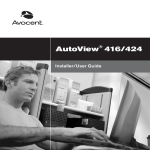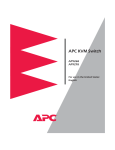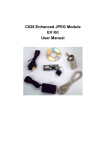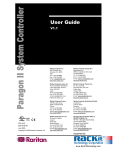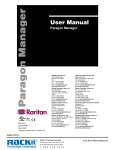Download CYBEX AUTOVIEW COMMANDER - User guide
Transcript
AutoView 424 Installer/User Guide ™ AV424 AV424R AV416 AV416R 4991 Corporate Drive Huntsville, Alabama 35805-6201 • USA 256-430-4000 (Fax) 256-430-4030 www.cybex.com Supported by TM Technology Corporation 274 Madison Avenue, New York, NY 10016 Tel: 212-679-0050 • Fax: 212-679-0040 E-mail: Sales@RackitTechnolog y.com www.RackitTechnology.com AutoView 424 Installer/User Guide ™ AutoView 424 Installer/User Guide Cybex Computer Products Corporation 4991 Corporate Drive Huntsville, Alabama 35805-6201 • USA (Tel) 256-430-4000 (Fax) 256-430-4030 www.cybex.com ©2000 Cybex Computer Products Corporation. All rights reserved. IBM, ScrollPoint, PC/AT and PS/2 are registered trademarks of International Business Machines Corporation. ScrollPoint is a trademark of International Business Machines Corporation. Expert Mouse is a registered trademark of Kensington Technology Group. Microsoft and IntelliMouse are trademarks or registered trademarks of Microsoft Corporation. Logitech and Kensington are registered trademarks of their respective companies. MouseMan, Marble and TrackMan are registered trademarks of Logitech, Inc. Cybex and the Cybex logo are registered trademarks of Cybex Computer Products Corporation. AutoView, Commander, LongView, AutoBoot and all part numbers are trademarks of Cybex Computer Products Corporation. IntelliMouse is a trademark of Microsoft Corporation. AutoView 424 Installer/User Guide FCC Notification Warning: Changes or modifications to this unit not expressly approved by the party responsible for compliance could void the user's authority to operate the equipment. Note: This equipment has been tested and found to comply with the limits for a Class A digital device, pursuant to Part 15 of the FCC Rules. These limits are designed to provide reasonable protection against harmful interference when the equipment is operated in a commercial environment. This equipment generates, uses and can radiate radio frequency energy and, if not installed and used in accordance with the instruction manual, may cause harmful interference to radio communications. Operation of this equipment in a residential area is likely to cause harmful interference in which case the user will be required to correct the interference at his own expense. Canadian Notification This digital apparatus does not exceed the Class A limits for radio noise emissions from digital apparatus set out in the Radio Interference Regulations of the Canadian Department of Communications. Le présent appareil numérique n'émet pas de bruits radioélectriques les limites applicables aux appareils numériques de la class A prescrites dans le Règlement sur le brouillage radioélectrique édicté par le Ministere des Communications du Canada. Table of Contents Chapter 1 - Product Overview Feature Overview ........................................................................................................................................................ 1 Compatibility ................................................................................................................................................................ 3 Chapter 2 - Installation Basic Install ................................................................................................................................................................... 5 Advanced Install ...................................................................................................................................................... 11 Chapter 3 - Basic Operations Overview ...................................................................................................................................................................... 13 Keyboard Control ..................................................................................................................................................... 14 Keyboard Switching ................................................................................................................................................ 15 System Control & Maintenance .......................................................................................................................... 16 Chapter 4 - On-Screen Display Operations Activating OSD ......................................................................................................................................................... 17 The OSD Window ..................................................................................................................................................... 18 The Command Menu .............................................................................................................................................. 19 Basic Channel Maintenance ................................................................................................................................ 20 The ID Window ......................................................................................................................................................... 22 Administrator Functions ........................................................................................................................................ 24 Chapter 5 - Advanced Operation Multiuser Operation ................................................................................................................................................ 27 Multi Chassis Operation ........................................................................................................................................ 28 Keyboard Translation ............................................................................................................................................. 30 Chapter 6 - Channel Scanning Choosing a Scanning Method ............................................................................................................................. 33 Turning Scanning On and Off ............................................................................................................................. 34 Scanning by List ....................................................................................................................................................... 35 Chapter 7 - Appendices A: AutoView Specifications .................................................................................................................................. 37 B: LongView Specifications .................................................................................................................................. 38 C: FLASH Upgrading ............................................................................................................................................... 39 D: Troubleshooting .................................................................................................................................................. 41 E: Problem Report .................................................................................................................................................... 45 AutoView 424 Installer/User Guide INSTRUCTIONS: The exclamation point within an equilateral triangle is intended to alert the user to the presence of important operating and maintenance (servicing) instructions in the literature accompanying the appliance. DANGEROUS VOLTAGE: The lightning flash with arrowhead symbol, within an equilateral triangle, is intended to alert the user to the presence of uninsulated “dangerous voltage” within the product's enclosure that may be of sufficient magnitude to constitute a risk of electric shock to persons. PROTECTIVE GROUNDING TERMINAL: A terminal which must be connected to earth ground prior to making any other connections to the equipment. POWER ON: This symbol indicates the principal on/off switch is in the on position. POWER OFF: This symbol indicates the principal on/off switch is in the off position. 1 Feature Overview Product Overview The AutoView 424 allows you to control up to 256 PC, Sun or USB computers with one keyboard, monitor and mouse. It supports Sun Workstations, USB computers, IBM PC/AT and PS/2 systems and 100% compatible machines with support for VGA, SVGA, XGA and XGA-II video. Sun and PS/2 keyboard and mouse peripherals connect through the rear of the unit. Multiplatform The AutoView 424 adds multiplatform capabilities to your switching system by simultaneously supporting any combination of PS/2, Sun or USB computers in the same system. Switch easily across platforms with AutoView 424’s on-ocreen menu system. Multiuser/Remote Access Capability The AutoView 424 supports two simultaneous users in the system. This second user may be placed up to 500 feet away from the AutoView 424 system. Builtin extension lets you place your second keyboard, monitor and mouse wherever you need them most. Within the base unit, AutoView 424 performs as a complete 2 x 24 matrix switch with both users independently accessing any of the 24 attached PCs at the same time. On-screen display capability Configure and control your AutoView 424 with on-screen menuing. Name your computer channels anything you wish, then select the desired computer from an easy-to-use menu. Secondary menus let you configure and initiate channel scanning and other system features. Advanced security for total control over system access Use the advanced multi-level security feature to configure and control server access for every type of user in the system. The administrator has full access privileges, while individual users can have viewing or viewing/editing capability for each attached server. FLASH Upgradable The AutoView 424 is FLASH upgradable. This allows you to update your firmware at any time through a simple serial connection to insure that your AutoView 424 is always running the most current version available. 1 AutoView 424 Installer/User Guide Mouse support The AutoView 424 offers support for numerous PS/2 mice including: IBM ScrollPoint, Logitech MouseMan Wheel, Logitech Trackman Marble Wheel, Logitech Trackman Marble FX, Kensington 4 Button Mouse, Microsoft Explorer Mouse and the Microsoft IntelliMouse family. Plug and play The AutoView 424 supports Plug and Play video and is compliant with the VESA DDC2B standard. Mouse translation For added compatibility with your current equipment, AutoView 424 features mouse translation capability. Operated through the AutoView 424, your mouse will work with any attached computer- regardless of whether the computer is Sun, USB or PS/2 mouse compatible! Expansion for up to 64 computers An AutoView 424 unit will support from one to 24 attached computers, or channels, depending on the model. If more than 24 channels are needed, multiple units can be cascaded together for expansion. An extra tier of units can be connected for a total of 256 attached computers in one system. “Keep Alive” feature AutoView 424’s “Keep Alive” feature allows attached servers to power the unit in the event of an AutoView 424 power failure. This prevents attached computers from locking up and keeps you from losing time and data. OSD Configuration Utility The OSD Configuration Utility allows the administrator to easily configure and download a channel list with defined users and access privileges to the entire system. This utility will also read and save your current configuration for extra security. AutoBoot technology The AutoBoot feature boots all attached servers during initial power-up or after a power failure. Computers are booted transparently without operator intervention, and may be powered-up one-at-a-time or all at once. When the power stabilizes, a channel may be selected. Built-in scanning capabilities A built-in scanning feature allows you to automatically monitor, or scan, connected computers without intervention. When keyboard activity is detected, scanning is suspended until all activity stops. Scanning then resumes with the next channel in sequence. Keyboard switching In addition to using the on-screen menus, you can also switch computer channels with a simple keyboard sequence. 2 Product Overview 16-port version The AutoView 424 is also available in a 16 port version known as the AutoView 416. Aside from the number of ports, all information in this manual that applies to the AutoView 424 is also applicable to the AutoView 416. A typical AutoView 424 configuration is shown below. Compatibility XGA/XGA-II support If you wish to use XGA or XGA-II video, you will need to purchase an adaptor available through Cybex. 3 AutoView 424 Installer/User Guide 2 Installation Basic Install 1. Power down all computers that will be part of your AutoView 424 system. Connecting your Local Peripherals 2. Plug your VGA monitor cable into the port labeled on the back of your AutoView 424. For SUN support plug your Sun connector into the port labeled “SUN”, for PS/2 peripherals, plug your PS/2 keyboard cable and your PS/2 mouse cable into the ports labeled and respectively. Note: A PS/2 keyboard will not function if a Sun keyboard is attached. However, you may use a PS/2 mouse with a Sun keyboard. PS/2 CONNECTIONS SHOWN VGA MONITOR CABLE PS/2 KEYBOARD CABLE PS/2 MOUSE CABLE 5 AutoView 424 Installer/User Guide Connecting your Remote Peripherals 3. Plug a standard Category 5 Unshielded Twisted Pair cable (up to 500 feet) into the RJ-45 style modular jack on the rear of the AutoView 424. Cybex C5T or Cybex P5T cable is strongly recommended to achieve best performance and maximum distance. If you use a different Category 5 cable, make sure it is terminated to the EIA (TIA) 568 B standard, commonly used for 10BaseT Ethernet. 4. Route the Category 5 cable to the location where you intend to place the secondary monitor, keyboard and mouse. 5. If you are using Remote PS/2 peripherals Connect your monitor, keyboard and mouse to the connectors on the rear of the LongView Receiver just as you would connect them to your computer. Make sure you connect your monitor’s power supply to appropriate electrical outlets. (Please note that the connector on the rear of the Receiver is not used in any AutoView 424 configuration. Do not connect anything to this connector.) 6 Installation If you are using Remote Sun peripherals (This will require a VAK-1 adaptor kit available from Cybex) If your monitor uses a 13W3 plug, connect the 15HDD male adapter to the port of your LongView Receiver and your monitor cable to your 15HDD adaptor. Otherwise, plug your monitor directly into the LongView Receiver. Plug the ends of the 6-pin mini-DIN male adaptors into the and ports on your LongView Receiver and then plug the Sun keyboard/ mouse cable into the VAK-1 adaptor. 6. Connect the Categor y 5 cable to the modular jack on the rear of the Receiver. 7. Connect the circular power plug from the wall mount power supply to the power port on the LongView Receiver. Then plug the power supply into a convenient electrical outlet. Verify that the Receiver’s POWER indicator is now lit. 7 AutoView 424 Installer/User Guide Cable Description Length CIFCM-4 CIFCM-8 CIFCM-15 CIFCM-30 PS/2 only/VGA PS/2 only/VGA PS/2 only/VGA PS/2 only/VGA 4 ft. 8 ft. 15 ft. 30 ft. CUSBM-4 CUSBM-8 CUSBM-12 USB/VGA USB/VGA USB/VGA 4 ft. 8 ft. 12 ft. CWSNM-4 CWSNM-8 CWSNM-15 CWSNM-30 SUN Kbd/Mouse 13W3 SUN Kbd/Mouse 13W3 SUN Kbd/Mouse 13W3 SUN Kbd/Mouse 13W3 4 ft. 8 ft. 15 ft. 30 ft. CVSNM-4 CVSNM-8 CVSNM-15 CVSNM-30 SUN Kbd/Mouse VGA SUN Kbd/Mouse VGA SUN Kbd/Mouse VGA SUN Kbd/Mouse VGA 4 ft. 8 ft. 15 ft. 30 ft. 8 Installation Connecting Computers to the AutoView 424 8. Locate the input cable appropriate to the computer you are connecting. (AutoView 424 cable types are identified on the previous page.) Plug this cable into any numbered channel port on the rear of the AutoView 424. The other end of the input cable will have up to three connectors depending on type. Plug these connectors into the matching ports on your computer. PS/2 KEYBOARD CABLE PS/2 MOUSE CABLE VGA MONITOR CABLE CIFCA CABLE SHOWN 9. Locate your next input cable. Repeat step 8 until all computers are properly attached to the AutoView 424. 9 AutoView 424 Installer/User Guide 10. Locate the power cord that came with your AutoView 424 unit and plug it into the IEC power connector on the AutoView 424. Make sure that the power switch is off, then plug the other end of the power cord into an appropriate AC wall outlet. This outlet must be near the equipment and easily accessible to allow for unplugging prior to any servicing of the unit. 11. Power-up your AutoView 424 unit first, then power up all attached computers. 12. If your remote location utilizes Sun peripherals, you will need to configure the AutoView 424 to recognize them before they can be used. To do this: a. At the local user, activate the on-screen display (OSD) by pressing either of the keyboard Control keys twice within one second. b. Press the Control key twice more to access Administrator Commands. c. Use your arrow keys to highlight “Administrator Functions” and press Enter. d. Highlight and select the “Remote User” menu selection. Use the space bar to cycle through peripheral types and select the ones appropriate to your system. Press Enter to select. The AutoView 424 and all attached computers should be powered-down before servicing the unit. Always disconnect the power cord from the wall outlet. 10 Installation Advanced Install Attaching Multiple AutoView 424 Units (Please note that CIFCM cables are required for cascading.) 1. Follow steps 1-8 of the Basic Install section for each cascaded unit. 2. Plug the 25-pin “mini-D” connector of your CIFCM input cable into any available channel port on the rear of your base AutoView 424 unit. 3. Plug the 15-pin video connector on the other end of the cable into the port labeled on your first cascading AutoView 424 unit. Plug the PS/2 mouse connector into the port. Plug the remaining 6-pin miniDIN keyboard connector into the port. 4. Repeat steps 2-3 for every cascaded AutoView 424 unit in your system. CASCADING UNIT BASE UNIT PS/2 KEYBOARD CABLE PS/2 MOUSE CABLE VGA MONITOR CABLE 5. Follow steps 9-11 of the Basic Install section to attach compters to the system. 6. Power-up your AutoView 424 unit(s) first, then all attached computers. 11 AutoView 424 Installer/User Guide 3 Basic Operations Overview Your AutoView 424 may be operated in a non-secure (no password required) or secure (password required) mode. All units ship defaulted to the non-secure mode. For information on implementing password security, see the “Administrator Functions” section of chapter 4. Computers may be powered-up one-at-a-time or all at once. No operator intervention is required during booting. A computer may now be selected via the on-screen display menu or, if you are in non-secure mode, keyboard hot-key sequence. There is one power status LED. This green LED will be illuminated when power has been applied to the unit. 13 AutoView 424 Installer/User Guide Keyboard Control The following notational conventions appear throughout this chapter to illustrate commands for operating the AutoView 424. Whenever you see one of the symbols listed on the left side of the table, substitute the corresponding steps or values listed on the right side of the table. Convention <CM> Key Sequence or Value Enter Command Mode: 1. Press and hold down the ‘Num Lock’ key. 2. Press and release the minus (-) key on the numeric keypad. 3. Release the ‘Num Lock’ key. Note: For alternate hot-key sequences, see ‘System Control & Maintenance’ later in this chapter. <Enter> Press the ‘Enter’ or ‘Return’ key. The <Enter> command is used to execute an instruction and exit from Command Mode. Addr The numbers on your AutoView 424 are your computers' addresses. Enter the number, 1-24, for the computer you're selecting. For cascaded systems, enter the address of the base unit, followed by a period, then the address of the cascaded unit. Example: You have an AutoView 424 unit cascaded from channel 4 of your base unit. To access the computer at channel 3 of this second (cascaded) unit, enter 4.3. <ESC> Press the ‘Escape’ key. The <ESC> command is used to exit Command Mode without executing an instruction. 14 Basic Operations Keyboard Switching One of the ways to change the active channel in a non-secured AutoView 424 system is by entering a short sequence of keystrokes on the keyboard. This is called keyboard, or hot-key, switching. Note: Hot-key switching is only available in the default non-secure state. For more information on secure versus non-secure operation, see the ‘Administrator Functions’ section of Chapter 4. The first set of keystrokes places your system in Command Mode. A grey window with a command line will appear. As long as you are operating in Command Mode, whatever you type will be interpreted as channel switch commands until the Enter or the ESC key is pressed to terminate Command Mode. None of the keystrokes entered will be forwarded to the attached computer until you exit Command Mode. Next, enter the address (Addr) for the channel you wish to select. Press Enter to accept the new channel. The following command line shows the proper format used to switch your active channel via keyboard. Key Sequence Action <CM>Addr<Enter> Selects an active channel via keyboard. Below is a sample of a keyboard switching session, with an accompanying explanation for each step. Key Sequence Action 1. <CM>6<Enter> Selects Channel 6 on the base unit as the active channel. 2. <CM>3.5<Enter> Selects the AutoView 424 attached to channel 3 on the base unit, then selects channel 5 on the cascaded unit. 3. <CM>7<Enter> Selects Channel 7 on the base unit as the active channel. 4. <CM>2.1<ESC> Exit Command Mode. The instruction is not executed. Channel 7 is still the active channel. 15 AutoView 424 Installer/User Guide System Control & Maintenance The following commands are used for system control and maintenance. Enter the command sequences to perform the actions described in the table below. Key Sequence Action <CM>Kn<Enter> Sets the keyboard scan set where n is a scan set number 1-3. <CM>MR<Enter> If you hot-plug your mouse cable, you may experience a loss of mouse signal. Use this command to restore the signal if you are using a PC with a standard PS/2 mouse driver. If you hot-plug your mouse cable, you may experience a loss of mouse signal. Use this command to restore the signal if you are using a PC with a Microsoft IntelliMouse or other wheel mouse driver. <CM>MW<Enter> <CM>AV<Enter> <CM>SG<Enter> <CM>SH<Enter> <CM>M+<Enter> Displays the current firmware version of your AutoView 424. Enables the scan Go command (By address only) Enables the scan Halt command Enables mouse suspension of scanning <CM>M-<Enter> Disables mouse suspension of scanning <CM>H1<Enter> Changes the hot-key sequence to the default: (NumLock, -) <CM>H2<Enter> Changes the hot-key sequence to the 1st alternate: (NumLock, *) <CM>H3<Enter> Changes the hot-key sequence to the 2nd alternate: (CTRL, ~) <CM>OSD0<Enter> Disables the OSD Sequence <CM>OSD1<Enter> Changes the OSD sequence to the default: (CTRL, CTRL) <CM>OSD2<Enter> Changes the OSD sequence to the 1st alternate: (Alt, Alt) <CM>OSD3<Enter> Changes the OSD sequence to the 2nd alternate: (Shift, Shift) <CM> <Enter> <CM>ZM<Enter> Use this command to resynchronize the mouse after a device or computer hot-plug. Repeat, if necessary, until synchronization is re-established. Note: Using this command while the mouse is operating correctly will cause the mouse to lose sync. 16 4 On-Screen Display Operations Activating OSD Activate on-screen display (OSD) by pressing either of the keyboard Control keys twice within one second. In non-secure mode, this brings up the main OSD Window, “Administrator Channel List”. In secure mode, activating OSD will bring up the “User Login” window. Type in your user name and press Enter. The system administrator should login as “Admin”, “Root” or “Administrator”. Type your password and press Enter. This will bring up your “Channel List”. If there is no keyboard activity, the login window will timeout after five minutes and go blank to allow the monitor’s energy saver to execute. Enter your OSD activation sequence to restore the login prompt. Note: All AutoView 424 units ship in the default non-secure state. For more information on secure versus non-secure operation, see the section ‘Administrator Functions’. 17 AutoView 424 Installer/User Guide The OSD Window This window lists all named channels in your AutoView 424 system. They will be listed alphabetically with their channel addresses and access status beside them. Beside the address there will be a small circle. If the circle is filled, the attached computer is powered on. When in secure mode, only the channels that are accessible to the logged in user will be listed. (See the section ‘Administrator Functions’ for more information.) CYBEX Control Panel Administrator Channel List Name Orla Valerie Kay Katrina Liz Alison Address 1 2 3 4 5 6 Access VK O O V VK O VK O V O VK O THE MAIN OSD WINDOW Use your up and down arrow keys and the page up and down keys to select a channel. Move immediately to the top or bottom of the list with the home and end keys. Press a letter while in the main OSD Window, and the Highlight Bar moves to the first channel name beginning with that letter. Press the letter repeatedly to scroll through all channels that begin with that letter from top to bottom. Press Enter to make the switch. To exit the OSD Window without changing channels, press Esc. To manually logout when in secure mode, press F10. 18 On-Screen Display Operations The Command Menu Once you have activated the main OSD Window, you can open the Command Menu by pressing either of the Control keys twice. The Command Menu options are selected in the same manner as channels in the OSD Window. Scroll the Highlight Bar up and down and press Enter when your selection is highlighted. CYBEX Control Panel Administrator Commands Add Channel Edit Channel Delete Channel Administrator Functions Scanning is OFF Setup Scan List Reset PS/2 Standard Mse/Kbd Reset PS/2 Wheel Mse/Kbd Version Information ENTER = activate ESC = exit THE COMMAND MENU If you are operating in non-secure mode or are the system administrator, you will have several options that do not appear in the User level Command Menu: Add Channel, Edit Channel, Delete Channel and Administrator Functions are all covered in separate sections in this chapter. Scanning is covered in Chapter 6. If you experience a loss of mouse signal while using the AutoView 424, select the ‘Reset PS/2 Standard Mse/Kbd’ option from this menu for a PC with a standard mouse driver or ‘Reset PS/2 Wheel Mse/Kbd’ if you are using a PC with a Microsoft IntelliMouse or other wheel mouse driver. This will reset and in most cases restore your mouse signal. These commands are equivalent to the <CM>MR<Enter> and <CM>MW<Enter> keyboard command listed in the ‘System Control & Maintenance’ section of this manual. Choose the option ‘Version Information’ to display on your monitor the current version level of your AutoView 424 firmware. Press the Esc key to clear this information from your screen. 19 AutoView 424 Installer/User Guide Basic Channel Maintenance Basic Channel Maintenance is performed from the Administrator Command Menu, and is available if you are operating in non-secure mode or if you are the system administrator. Here you can add, delete or edit individual channels. CYBEX Control Panel Add Channel Name Address ID Dwell Time 5 Scan Dwell Time 5 ID Setup Save Changes ENTER = activate ESC = exit THE ADD CHANNEL WINDOW Adding Channels 1. Select ‘Add Channel’ from the Administrator Command Menu or press the Insert key. Type in a new channel name, up to 14 characters long, and press Enter. 2. Type in the address for the computer you are naming and press Enter. Please note that the address cannot be longer than two digits. (For cascaded addresses see ‘Keyboard Switching’ in Chapter 3.) 3. Enter the dwell time for the ID Window and press Enter. 4. Enter the dwell time for scanning and press Enter. 5. After selecting “ID Setup”, use the arrow keys to position the ID window where you would like it to appear when this channel is selected. Then press Enter. (For further information see ‘The ID Window’ later in this chapter.) Press Esc at any point to exit this operation without adding the channel. 20 On-Screen Display Operations Editing Channel Names and Addresses 1. Highlight the channel you wish to change in the main OSD Window. 2. Press the Control key twice to access the Command Menu or press the F2 key once. (If you press F2, skip Step 3.) 3. Select ‘Edit Channel’ from the Command Menu. 4. Enter the new channel name, address, ID Dwell time and Scan Dwell time. Press Enter to accept. 5. After selecting “ID Setup”, use the arrow keys to position the ID window where you would like it to appear when this channel is selected. Then press Enter. (For further information see ‘The ID Window’ later in this chapter.) 6. Select “Save Changes” and press Enter to accept. Press Esc at any point to exit this operation without saving the changes. Deleting an Existing Channel 1. Highlight the channel you wish to delete in the main OSD Window. 2. Press the Control key twice to access the Command Menu or simply press the DELETE key. (If you press DELETE, skip Step 3.) 3. Choose the ‘Delete Channel’ option. 4. Type Y or N at the prompt to confirm the deletion and press Enter. 21 AutoView 424 Installer/User Guide The ID Window The ID Window appears when you change channels and displays the name of the selected channel. This window can be individually configured for each channel in your system. The characteristics of the ID Window can be changed from the Edit Channel Menu. This option is only available if you are operating in non-secure mode or if you are the system administrator. Changing the Size, Color and Position of the ID Window 1. Highlight the channel you wish to change in the main OSD Window. 2. From the main OSD Window, press the Control key twice to access the Command Menu or press F3. (If you press F3, skip Step 3) 2. Select ‘Edit Channel’ from the Command Menu. 3. Choose the option ‘ID Setup.’ Follow the procedures outlined in the table below to change the size, color or position of your ID Window. Operation Procedure Move the ID Window Use the arrow keys to move the ID Window's position on the monitor. (Hold down the SHIFT key to move slower.) If the window flickers but does not move, continue tapping the arrow keys until it moves back into range. Change window background color Press the <PAGE UP> key to cycle through the available window background colors. Change text color Press the <PAGE DOWN> key to cycle through the available text colors. Change window length Use the (+) and (-) keys to change the length of the ID Window. Change window size Press SPACE to toggle between large and small. ID Window Help Press F1 22 On-Screen Display Operations 4. Press Enter to accept the changes or press Esc to exit the menu without saving the changes. Setting the ID Window Dwell Time This menu selection lets you set the time that the ID Window remains on screen after a channel switch. Each channel can be configured independently. The default time is set for five seconds. 1. Highlight the channel you wish to change in the main OSD Window. 2. From the main OSD Window, press the Control key twice to access the Administrator Command Menu. 3. Select ‘Edit Channel’ from the Command Menu. 4. Choose the option ‘ID Dwell Time’. 5. Enter a number between 0-255 seconds. Entering 0 disables the ID Window. Entering 255 allows the ID Window to stay on screen the entire time the channel is active. 23 AutoView 424 Installer/User Guide Administrator Functions The Administrator Functions Menu is accessed from the Administrator Commands Menu. Here, you can setup the administrator and user accounts, enable and disable the setup port and utilize the AutoView 424’s FLASH upgrade feature. Differences between Secure and Non-Secure Operating Modes Administrator Account Setting up an administrator account with a password places your system in secure mode. Non-secure systems do not use passwords. To return your system to the default of non-secure mode, simply delete the administrator password. When the administrator password is enabled, user passwords must also be entered or the switch will not be completely secure. The default for users is no password. Simply press Enter at the prompt. If you configure an administrator password from this menu, your system will then be in secure mode. A lock symbol will appear to the right of the menu headings to indicate secure operation. Logout Capability You have the option of automatically logging out of the system after an administrator defined period of inactivity. Timeout values can be set from 0 to 60 minutes. (Default is five minutes). A value of 0 keeps the user logged in continuously. When the timeout is reached, the current channel is deselected and the display goes to the login prompt. Users must login again to access system computers. This option is only available in secure mode. Multiple User Logins You can create up to four user logins in addition to the system administrator. Use these logins to configure and control server access for every type of system user. The administrator has full access privileges; additional users can have no access. viewing or viewing with keyboard and mouse control capability for each attached server. This option is only available in secure mode. 24 On-Screen Display Operations Creating the Administrator Account 1. Press the Control key twice to access the Command Menu. 2. Select ‘Administrator Functions’ from the Command Menu. 3. Select ‘Setup Administrator’ from the Administrator Menu. 4. Type your password and press Enter. (The password is not case sensitive.) 5. Repeat entry of the password for confirmation. 6. Enter the number of minutes you wish to pass without keyboard/mouse activity before the administrator is automatically logged out of the system. Entering a 0 keeps the administrator logged on continuously; 60 is the maximum setting. CAUTION: Security is enabled once the password has been created. Store a copy of your password in a safe place. You should now see the option ‘F10 - Logout’ at the bottom of your main OSD Window and a lock symbol to the right of the menu headings. Setting Up Additional Users 1. Press the Control key twice to access the Command Menu. 2. Select ‘Administrator Functions’ from the Command Menu. 3. Select ‘Setup User 1’ from the Administrator Menu. 4. Choose the ‘Name’ heading and enter the name for this user. 5. Choose the ‘Password’ heading and enter the password and confirm it for this user. (Passwords are not case sensitive.) 6. Choose the ‘Logout Time’ heading. Enter a value in minutes for this user’s logout time. A value of 0 keeps the user logged on continuously; 60 is the maximum setting. The default is set for 5 minutes. 25 AutoView 424 Installer/User Guide 7. Choose the ‘Access Setup’ heading. Here, you will see a listing of all attached servers in the channel list. For each server, choose a level of access for this user by selecting one of the function keys listed on the screen: F5 for no access, F6 for video only or F7 for video and keyboard/ mouse capability. The default is set for full access. All changes go into effect as soon as they are made. Press Enter when you have completed your configuration. 8. Press Enter to accept your selections and repeat steps 3-7 for each remaining user. Remote User The AutoView 424 supports both PS/2 and Sun peripherals at the remote user location. Use this menu option to select the peripherals that are appropriate to your remote setup. Switch Selection Depending on your particular installation, you may not want unpowered computers to be accessible. If Switch Selection is toggled to “All Channels” the AutoView 424 will switch to a connected system regardless of power state. By default, the AutoView 424 will only switch to systems that are powered on. Setup Port Operations Cybex offers enhancement products that allow you to customize the AutoView 424 through the setup port. Features include automated OSD programming via the OSD Configuration Utility and FLASH Upgrades. Depending on the application, you may be asked to enable the setup port in the instructions that come with your AutoView 424 enhancement. FLASH Upgrades FLASH Upgrading allows you to update the code that runs your AutoView 424 and keep it current with the latest firmware revisions. For more information, see Appendix B. 26 5 Multiuser Operation Advanced Operation The AutoView 424 provides advanced features that go beyond those available in the standard AutoView Commander. Primarily, it offers the benefit of adding a LongView Receiver to provide for a remote user that may be located up to 500 feet away from the AutoView 424. The remote user has all the capabilities of the local user and can access any computer attached to the AutoView 424 system just as if he were sitting in front of it. Within the base unit, there are two ways to utilize the multiuser capabilities of the AutoView 424. You can access computers independently or share access with the other user. Independent Access As long as both users are trying to access computers attached to the base AutoView 424 unit, they may access any of them independently at the same time. In the diagram below, either user may access any of the attached computers at any time. They may also share access to any of the attached computers. 27 AutoView 424 Installer/User Guide Shared Access If both users need to access the same computer in the base unit, they can ‘share’ access to it through the AutoView 424. Sharing means that both consoles can view a computer channel at the same time, but only one can enter data through the keyboard or mouse at any given moment. As soon as the active console stops all keyboard and mouse activity, the other console can take control of the computer. For information on access across multiple AutoView 424 units, see ‘Multi Chassis Operation’ below. Multi Chassis Operation Multi chassis operation involves independent access only. Both users can simultaneously and independently access any computer attached to the base AutoView 424 unit. Similarly, independent access is possible across units as long as each user is accessing a different AutoView 424 unit. Example For example, in the configuration below, two users can access nine computers through three AutoView 424 units. 1 1 2 2 3 Unit 3 3 1 2 3 Unit 2 Base Unit 28 Advanced Operation Example (Cont’d) 1) Both users can independently access the three computers attached to the base unit at any time. 2) Both users can independently access any computer in a different AutoView 424 unit at any time. If one user is working on channel 1 of the base unit, the other user can be independently using computers 2 or 3 of the base unit, or any computer attached to units 2 or 3. If one user is working on channel 2 of unit 2, the other user can be independently using any computer attached to the base unit or unit 3. This user cannot independently access any computer attached to unit 2 until the first user connects to a computer attached to a different AutoView 424 unit. 29 AutoView 424 Installer/User Guide Keyboard Translation The AutoView 424 allows you to use PS/2 or Sun keyboards to operate any type of attached computer. However, when crossing platforms, certain keys will need to be ‘remapped’ in order to provide all of the functions available on the keyboard native to that platform. For example, if you access a Sun workstation with a PS/2 keyboard, you will notice that the PS/2 keyboard does not have the STOP and AGAIN keys that are on a true Sun keyboard. But, by turning Scroll Lock on, the F1 and F2 keys on the PS/2 keyboard function as the Sun STOP and AGAIN keys. With Scroll Lock off, F1 and F2 function normally. Table 1 below shows the translations for a PS/2 keyboard to a Sun computer. All mapped functions in Table 1 will only be valid when the Scroll Lock is on. Table 1: PS/2 Keyboard to Sun Computer Key Sun Key Sun F1 STOP F9 FIND F2 AGAIN F10 CUT F3 PROPS F11 POWER F4 UNDO F12 COMMAND F5 FRONT keypad * COMPOSE F6 COPY NUMLOCK HELP F7 OPEN keypad / MUTE F8 PASTE keypad - VOL - keypad + VOL + 30 Advanced Operation Sun keyboards have a power key used to power the workstation on and off. PS/2 keyboards may have a sleep key to place the computer in a stand-by or power saving mode. Table 2: Power/Sleep for USB Computers Peripheral Keyboard PS/2 Scroll Lock Shift-F11 On Win 98/2000 F11 On Win 98/Mac On Off On Off Win Win Win Win Sleep Sun Computer Key Power 98/Mac 98/2000 98/2000 98/Mac To issue the Power/Sleep command to a PS/2 computer, type Scroll Lock, F11 (or Sleep key). For a Sun computer, use the Power key. 31 AutoView 424 Installer/User Guide 6 Channel Scanning Choosing a Scanning Method AutoView 424's scanning feature allows you to automatically monitor, or scan, your computer channels without intervention. When keyboard activity is detected, scanning is suspended until all keyboard activity stops. Scanning then resumes with the next channel in sequence. The length of time each channel remains on the screen, or dwell time, is configurable and can be changed at any time. There are multiple ways to scan through the channels in your AutoView 424 system, either by name, address or list. Please note that the AutoView 424 only scans the computers that are in your OSD list. Scanning by address allows you to view each of your active channels in the order that they are attached to the AutoView 424. Scanning by name allows you to scan channels in alphanumeric order according to the channel list in the main OSD Window. Scanning by list allows you to create a customized scanning order for the switch to follow. Any active port in the system can be scanned in any order, as many times as desired. With all scan methods, you can adjust the dwell time for each channel or omit a channel from the scan sequence completely. Choose whichever method is most appropriate for your configuration. 33 AutoView 424 Installer/User Guide Turning Scanning On and Off From the OSD menu. 1. From the main OSD Window, press the Control key twice to access the Command Menu. 2. Select ‘Scanning is OFF’, ‘Scanning by Name’, ‘Scanning by Address’ or ‘Scanning by List’ from the menu. This is a toggle option - only one scanning option will show on the menu at any one time. Selecting ‘by Name’ will scan channels alphabetically by name; choosing ‘by Address’ will scan channels alphanumerically by channel address. 3. Press Enter. By keyboard hot-key sequence The following key sequences control scanning. Key Sequence Action <CM>SG<Enter> Enables the scan Go command. (By Address Only) <CM>SH<Enter> Enables the scan Halt command. 34 Channel Scanning Scanning by List Scanning by list allows you to create a customized scanning order for the switch to follow. Any active channel in the system can be scanned in any order, as many times as desired. To configure the scan list, open the main OSD window by pressing either of the Control keys twice. Press them twice more to access the Command Menu. From the Command Menu, use your arrow keys to highlight ‘Setup Scan List’ and press the Enter key. This will activate the Administrator Scan List menu where you can add or delete users from your custom scan list. CYBEX Control Panel Administrator Scan List Address 1 2 3 4 Dwell 5 5 5 5 F2 - Add Enter - Save Name Kyle Pam John Charlene F3 - Delete Esc - Cancel To add a channel to the Scan List. 1. Press the F2 key to open a new selection. 2. Type the address of the channel you want to add to the list. The Dwell time and channel name are updated automatically from the channel configuration menu. 3. Press Enter to save the new entry or Esc to cancel. To delete a channel from the Scan List. 1. Use the arrow keys to highlight the channel that you wish to delete. 2. Press the F3 key. 3. Press Enter to confirm the deletion. 35 AutoView 424 Installer/User Guide 7 Appendices A: AutoView Specifications Mechanical Height: 1.7" (4.5 cm) Width: 17.2" (43.7 cm) Depth: 6.5" (16.51 cm) Weight: 6.0 lbs (2.72 kg) Environmental/ Power Operating Temperature: 41° (5°C) to 104° (40°C) Storage Temperature: -4° (-20°C) to 122° (50°C) Operating Voltage: 100 - 240 VAC Power Frequency: 50 - 60 Hz Supported Hardware Computer: IBM PC/AT, PS/2, Sun workstations, USB computers and 100% compatibles Video Modes: VGA, SVGA, (XGA, XGA-II with adaptor) Maximum Resolution: 1600 x 1200 @ 85 Hz Peripherals: PS/2 keyboard, PS/2 mouse, Microsoft Explorer mouse, Microsoft IntelliMouse Family, IBM Scrollpoint, Logitech Mouseman Wheel, Logitech Trackman Marble wheel, Logitech Marble FX and Kensington 4 button mouse, Sun Type 5 and Type 6. Agency Approvals UL 1950, CSA C22.2 No. 950, EN60950 FCC part 15A, EN55022, EN50082 37 AutoView 424 Installer/User Guide B: LongView Specifications Mechanical Height: 1.9" (4.8 cm) Width: 8.1" (20.6 cm) Depth: 4.8" (12.2 cm) Weight: 1 lb. (0.45 kg) Environmental/ Power Operating Temperature: 5°C to 40°C Storage Temperature: -20°C to 50°C Power Supply: 24Vdc @ 500mA from120 Vac adaptor 38 Appendices C: FLASH Upgrading To upgrade the FLASH code on your AutoView 424, you will first need to obtain the latest FLASH firmware revision from Cybex. It is available through Cybex Technical Support. Next you will need a serial cable (available at most electronics stores) to connect a computer to your AutoView 424. Simply connect the serial cable between the SETUP port on your AutoView 424 to the serial port on the computer. You will next need some form of terminal software on your attached computer so that it can communicate with the AutoView 424. There are several that are commercially available. Select one that you are comfortable with and be sure that it can communicate at 38,400 baud. 39 AutoView 424 Installer/User Guide Configure your terminal program to the following settings: 38,400 Baud 8 Bits No Parity 1 Stop Bit No Flow Control Once setup is complete, the following steps will finish the upgrade: 1. Activate the OSD menu on your AutoView 424 by tapping the Control key twice. Enter Control twice more to activate the Administrator Commands screen and then select Administrator Functions. 2. Use the down arrow key to highlight the menu selection for FLASH Upgrade, then press Enter. 3. A menu screen will appear, requiring verification to continue. You must type out the word ‘Yes’ before proceding. Once you have done this, the AutoView 424 will go into a standby mode and wait for data from the computer. (Note: The keyboard, video and mouse are disabled during the FLASH upgrade.) 4. The final step is to send the FLASH file from your terminal program. To do this, you will need to use the transfer function of your communications software. Send the FLASH file using the XMODEM protocol. The transfer should be completed within four minutes. The AutoView 424 will automatically check the upgrade and make sure that it is valid. If the AutoView 424 detects an error it will abort the upgrade and prompt you to re-transfer the file. Otherwise, it will return the message “Flash Upgrade Successful”. 40 Appendices D: Troubleshooting Our Technical Support staff is ready to assist you with any installation or hardware problems you encounter with your Cybex product. If a problem should develop, follow the steps below for the fastest possible service: 1. Check the troubleshooting tables below to see if the problem can be resolved by following the procedures outlined. 2. If you are unable to find a resolution, recreate the problem when possible. Fill out the Problem Report in Appendix E completely. 3. Call Cybex Technical Support for assistance. Have your Problem Report with you when you call or fax it to Technical Support directly. To expedite assistance, have this manual available, along with a copy of your invoice giving the date purchased and other identifying data. Symptom Action No status light Verify unit is turned on. Check power cable. If the problem persists, contact Cybex Technical Support. Unable to hot-key switch to a channel Check the power indicator on the OSD screen to ensure that the system in question is powered. Verify that you are not in secure mode. (No lock symbol on OSD screen.) No video Verify that the video cable between the computer and the AutoView 424 is correctly connected. Verify that the monitor cable is correctly connected to the AutoView 424. Power down the computer. Connect the monitor directly to the computer and power up again. If the monitor operates correctly direct to the computer, contact Cybex Technical Support. If it does not, try another monitor. Mouse jumps or “hugs” screen If the mouse has been hot-plugged while running in Windows, you may need to close and restart Windows. If the mouse still does not function, try the mouse resynchronization command <ZM>. (For instructions on command mode, see 'Basic Operations'.) If the problem persists, contact Cybex Technical Support. 41 AutoView 424 Installer/User Guide Symptom Action Mouse is inoperable on one computer channel If the mouse is inoperable on a channel, try the mouse reset command <MR> or <MW> with that PC selected. (For instructions on command mode, see ‘Basic Operations’.) Verify that the cables from the computer to the AutoView 424 are connected properly. Make sure that you have keyboard/mouse privileges for that channel. Verify that the mouse driver and application are configured properly for mouse support. Verify that the computer works properly with a mouse connected directly to it. If the problem persists, contact Cybex Technical Support. Mouse is inoperable on all computer channels Verify that the mouse is plugged into the correct PS/2 port on the back of the AutoView 424. Try the mouse reset command <MR> or try the ‘Reset PS/2 Standard Mse/Kbd’ command from the OSD Command Menu for computers using PS/2 mice. Use <MW> or ‘Reset PS/2 wheel Mse/Kbd’ for computers using the Microsoft IntelliMouse. (For instructions on command mode, see the ‘Basic Operations’ chapter.) Verify that the mouse works when connected directly to a computer. Cycle power to the AutoView 424 unit. (You do not have to power down your computers for this.) If the mouse remains inoperable, power down all attached computers, cycle power on the AutoView 424, then repower the computers. If the problem persists, contact Cybex Technical Support. Remote Video is unrecognizable Verify the remote monitor capabilities are equal to or greater than the local monitor capabilities. Plug and Play video is only supported on the local video port. 42 Appendices Symptom Action Keyboard is inoperable on one computer channel If keyboard does not function on one channel, verify that the cables from the computer to the AutoView 424 are connected properly. If you are operating in secure mode, verify your keyboard and mouse privileges. Verify that the keyboard works properly connected directly to the computer. If the problem persists, contact Cybex Technical Support. Keyboard is inoperable on all channels If the keyboard does not work on any channel, try the ‘Reset PS/2 Mse/Kbd’ command from the OSD Command Menu. Try a different keyboard. If the keyboard still does not function, cycle the power on the AutoView 424 unit. Cycle power on all attached computers and the AutoView 424 unit and try again. If the problem persists, contact Cybex Technical Support. Keyboard is inoperable after switching channels If you are operating in secure mode, verify your keyboard and mouse privileges. If the problem persists, call Cybex Technical Support. Try changing the keyboard scan set for that channel by using the keyboard command sequence <Kn>. (For more information, see the ‘Basic Operations’ chapter.) Characters on screen do not match keyboard input Try changing the keyboard scan set for that channel by using the keyboard command sequence <Kn>. (For more information, see the ‘Basic Operations’ chapter.) If the problem persists, call Cybex Technical Support. No keyboard, video or mouse on expansion unit; base unit is functioning properly Verify that the cable connecting the two units together is correctly connected on both ends. (For additional information, see the ‘Installation’ chapter.) If the problem persists, contact Cybex Technical Support. 43 AutoView 424 Installer/User Guide Symptom Action OSD menu does not “pop-up” Type <CM>OSD1<Enter> to activate OSD. Verify that you are pressing the Control key twice within one second. If the problem persists, contact Cybex Technical Support. Unable to change channels using OSD Verify that the channel is powered. Check the address configured in OSD. If the computer is powered and the address is correct, call Cybex Technical Support. Administrator password is forgotten Call Technical Support. User password is forgotten Contact your system administrator. General Keyboard/Video Problems If the building has 3-phase AC power, ensure that the computer, the AutoView 424 and the monitor are on the same phase. Best results are obtained when they are on the same circuit. Use only Cybex supplied cable. Cybex warranties do not apply to damage resulting from user supplied cable. Do not use a 2-wire extension cord in any Cybex product configuration. Test AC outlets at computer, AutoView 424 and monitor for proper polarity and grounding. Use only with grounded outlets at the computer, AutoView 424 and monitor. When using a backup power supply (UPS), power the computer, AutoView 424 and the monitor off the supply. Poor Video Quality at Remote User Verify that the length of Category 5 cable between the AutoView 424 and Receiver is 500 ft or less. Make sure the video connectors at both ends are firmly seated. Make sure that the Category 5 connectors are properly inserted. Make sure that the modular plugs on the Category 5 cable were properly crimped onto the cable. 44 Appendices E: Problem Report For the best possible service, please fill out this form completely. Have your completed Problem Report with you when you call, or fax it to Technical Support directly. Company Name: Contact Name: Phone Number: Fax Number: Service Call Number (if one has been issued): AutoView 424 Part #: Serial #: Revision: Name and Model of Monitor: Name and Model of Keyboard: Name and Model of Mouse: Version Information: : List any equipment attached to the AutoView 424. (Include other Cybex products, additional peripherals, adaptors, etc.): 45 AutoView 424 Installer/User Guide Problem Description: (Include all affected ports, exact nature of problem, troubleshooting steps taken, etc.) Fill out the chart below, including every computer attached to your AutoView 424 system. Port Computer Manufacturer/ Model BIOS Manufacturer / Revision A B C D E F G H 46 Operating System Graphics Card Name/Model Video Resolution / Scanrate AutoView 424 Installer/User Guide Warranty Cybex Computer Products Corporation warrants to the original retail purchaser that this product is and will be free from defects in materials and workmanship for a period of 12 months from the date of purchase. Additionally, all Cybex products carry an unconditional 30 day satisfaction guarantee. If, for any reason, you are dissatisfied with the performance of this product, you may return it to the point of purchase for a refund of the purchase price (excluding shipping charges). This guarantee does not apply to special order products, and may not be available through all resellers. During the warranty period, purchaser must promptly call Cybex for a Return Materials Authorization (RMA) number. Make sure that the RMA number appears on the packing slip, proof of purchase, AND ON THE OUTSIDE OF EACH SHIPPING CARTON. Unauthorized returns or collect shipments will be refused. Ship prepaid to: Cybex Computer Products Corporation 4991 Corporate Drive Huntsville, AL 35805-6201 USA Telephone: (256) 430-4000 The warranty is void under the following conditions: 1. If non-Cybex approved cabling is attached to the AutoView 200. Poorly constructed and miswired cabling can diminish video quality and damage equipment. Cybex manufactured cabling is built to high quality standards utilizing overall braided shield to comply with FCC emission standards, and each cable is individually tested under load. 2. If defect or malfunction was caused by abuse, mishandling, unauthorized repair, or use other than intended. 3. If unauthorized modifications were made to product. 4. If unreported damages occurred in any shipment of the product. 5. If damages were due to/caused by equipment or software not provided by Cybex. 6. If the AutoView 200 is used with non-grounded or incorrectly polarized AC power. EXCEPT AS SPECIFICALLY PROVIDED ABOVE, CYBEX COMPUTER PRODUCTS CORPORATION MAKES NO WARRANTIES EITHER EXPRESS OR IMPLIED AS TO ANY MATTER WHATSOEVER, INCLUDING, WITHOUT LIMITATION, THE CONDITION OF THE PRODUCT, ITS MERCHANTABILITY, OR ITS FITNESS FOR ANY PARTICULAR PURPOSE. EXCEPT AS EXPRESSLY PROVIDED ABOVE, CYBEX COMPUTER PRODUCTS CORPORATION SHALL NOT BE LIABLE FOR LOSS OF PROFIT, LOSS OF BUSINESS, SPECIAL OR CONSEQUENTIAL DAMAGES, OR OTHER FINANCIAL LOSS WHICH MAY BE CAUSED BY, DIRECTLY OR INDIRECTLY, THE INADEQUACY OF THE PRODUCT FOR ANY PURPOSE OR USE THEREOF OR BY ANY DEFECT OR DEFICIENCY THEREIN EVEN IF CYBEX COMPUTER PRODUCTS CORPORATION OR AN AUTHORIZED CYBEX DEALER HAS BEEN ADVISED OF THE POSSIBILITY OF SUCH DAMAGES OR LOSSES. AutoView 424 Installer/User Guide Cybex Computer Products Corporation 4991 Corporate Drive Huntsville, Alabama 35805-6201 • USA Tel: 800 932 9239 Fax: 256 430 4031 E-Mail: [email protected] Cybex Computer Products International Ltd. Cybex House Shannon Free Zone Shannon, Co. Clare, Ireland Tel: 00353 61 715 292 Fax: 00353 61 471 871 E-mail: [email protected] Cybex Germany Dachauerstrasse 44a 80335 Munchen Germany Tel:. 0049 89 599 0830 Fax: 0049 89 599 08350 E-mail: [email protected] Cybex Asia Pacific Singapore Representative Office 19-B Bukit Pasoh Road Singapore 089833 Tel: 0065 223 9198 Fax: 0065 223 9155 E-mail: [email protected] Cybex Canada Limited 20 Mural Street, Unit#45 Richmond Hill Ontario, L4B 1K3 Tel: 1 877 992 9239 Fax: 1 877 524 2985 E-mail: [email protected] ® SWITCH TM Supported by ® Technology Corporation 274 Madison Avenue, New York, NY 10016 Tel: 212-679-0050 • Fax: 212-679-0040 590-151-001 Rev A.
























































